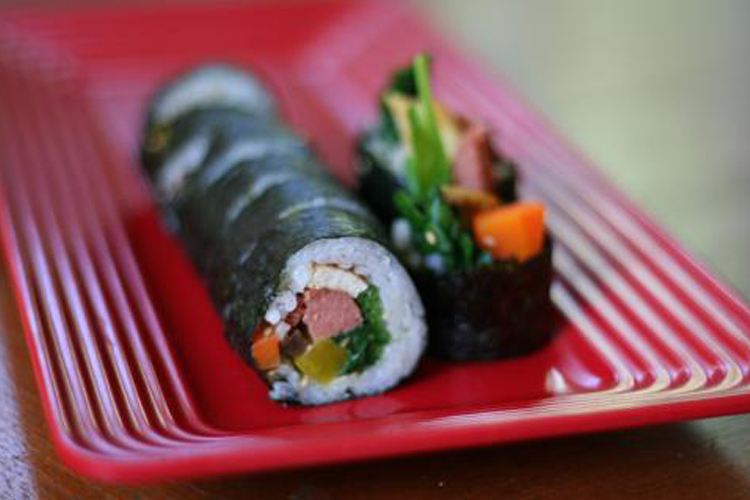Hot dogs are always eaten with buns, right? That may be how Americans consume their Oscar Meyers, but in many other parts of the world, hot dogs are incorporated into the local cuisines. In places where the U.S. military has historically had a presence, surplus army rations — including Spam and hot dogs — were introduced to the local population, which incorporated them into their fare. Prompt any Filipino child with “spaghetti and…” they will finish the sentence not with “meatballs,” but “hot dogs!” In Korea, hot dogs might be found in a stew, or simply with white rice and seaweed.
I was first introduced to Korean food through a Korean Baptist church. This particular house of worship was theologically strictly Southern Baptist: no drinking, no dancing, and members of the congregation addressed each other as “Brother” and “Sister.” The church was also culturally very Korean. Elders were addressed with the proper honorific terms: “Ajooma” for the older ladies and “Ajooshi” for the older gentlemen.
Like any faith community, this body has its share of church luncheons and picnics, all involving vast quantities of Korean food prepared by the church ladies in the basement kitchen. The picnics included the standard hamburgers and hot dogs, supplemented by marinated barbecued short ribs (galbi) and kimbap.
Kimbap is a rice roll, similar to the Japanese futomaki style of sushi. Given its cooked ingredients, kimbap is not only tasty and easily eaten with the fingers, but it travels well as picnic food. Inside the seaweed wrapper is sesame oil seasoned rice, steamed vegetables, egg, and some form of meat — usually bulgogi (Korean barbecued beef), sometimes fish cake, occasionally Spam or hot dogs.
I suspect Spam and hot dogs contain — for the most part — similar ingredients (no need to get into specifics). But while Spam is all tinny, government surplus rations, hot dogs are pure fun.
In my recipe, I have chosen to use Hebrew National franks. Besides being of good quality (like the Baptists, they answer to a higher calling), it also allows me to segue into a joke about the Korean Baptist minister and the Rabbi who walked into a bar. Okay, that probably wouldn’t happen, but if they did, perhaps they could have shared a plate of hot dog kimbap.
Hot Dog Kimbap
Ingredients
- Seaweed sushi wrappers
- 2 cups short grain white rice
- 3 tablespoon sesame oil
- 1 teaspoon sugar
- 1 teaspoon salt
- 1 bunch spinach
- 3 carrots
- 3 eggs, lightly beaten
- 3 hot dogs
- Takuwan (pickled daikon radish) and pickled burdock root (optional, if you can find it at an Asian market), sliced into thin long strips
Special equipment: You will need a bamboo sushi rolling mat
Directions
- Cook rice according to directions, or with slightly less water, to keep the grains from turning mushy.
- Blanch or steam spinach and carrots until barely cooked. Slice the carrots into long, 1/4″ wide strips.
- Fry the eggs in a lightly oiled skillet as if making a thin pancake. Let cook until set on one side, then flip the entire thing over without breaking it. Slice into thin strips.
- Heat the hot dogs in a skillet until they turn slightly brown and plumped. Slice lengthwise into quarters. Have all the ingredients ready when the rice finishes.
- While rice is still warm sprinkle with salt, sugar and sesame oil. Gently mix the rice and seasonings by turning sections of it with a rice paddle or large spoon, to not smash it into a paste.
- Place a sheet of seaweed on the bamboo mat. Spread a thin layer of rice on the bottom four or five inches of the seaweed. In the middle of the rice, carefully arrange the strips of vegetable, egg and hot dog. Sprinkle with sesame seeds, and a little more sesame oil if desired.
- Without lifting up the bamboo mat, take the bottom of the sheet and fold the rice over the fillings, forming a roll. You may need to press loose fillings in as you do this to keep the roll looking nice. You should now see only plain rice and the non-rice end of the seaweed ahead of you as your roll from the bottom up. If necessary, sprinkle a little water on the inside of the seaweed to help it stick together when you have rolled everything together into a tube.
- When you have formed the roll, then wrap the bamboo mat around the whole thing and gentle squeeze. This helps the kimbap to hold together without sticking to your fingers.
- Repeat with the remaining ingredients, then slice into 3/4″ rounds with a sharp knife. Dipping the knife lightly into water between slices will help prevent sticking.

